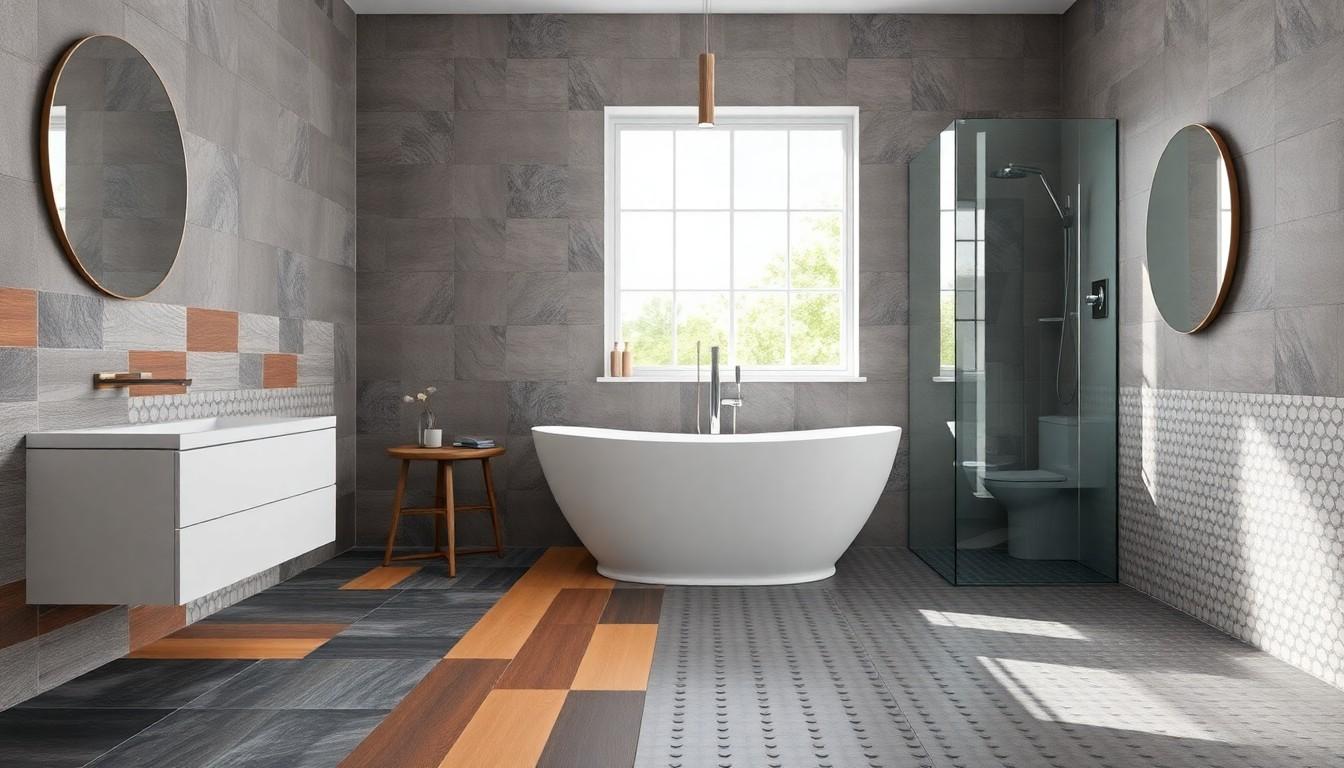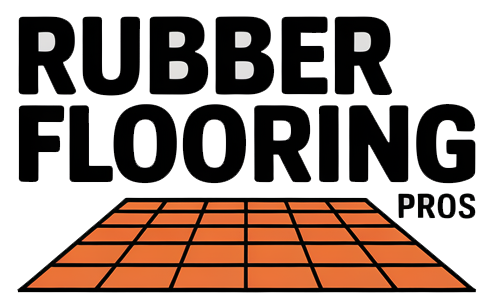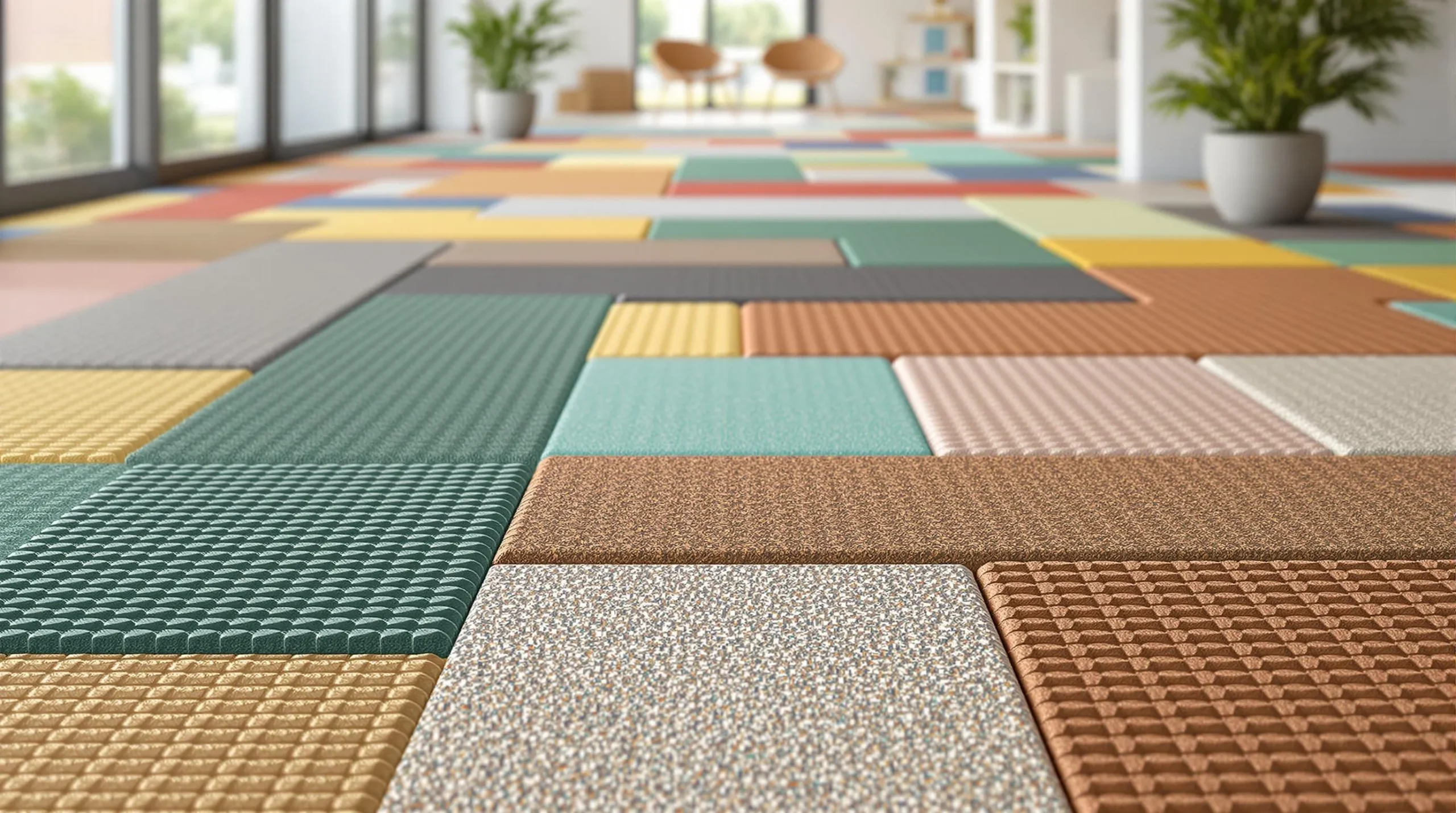Transforming your bathroom into a safe and stylish space starts from the ground up. Whether you’re renovating or building from scratch, rubber flooring offers a unique blend of practicality and contemporary aesthetics that’s perfect for modern bathrooms.
You’ll find that rubber bathroom flooring isn’t just about preventing slips and falls. It’s a versatile option that combines comfort underfoot with exceptional durability and water resistance. Plus, with today’s innovative designs and colour options, you’re no longer limited to the utilitarian look of traditional rubber floors – you can create a bathroom that’s both functional and fashionable.
Key Takeaways
- Rubber bathroom flooring offers exceptional slip resistance and water-resistant properties, making it a safe and practical choice for wet environments.
- Available in three main formats – sheet rubber, tiles, and studded flooring – each offering unique benefits for different installation needs and design preferences.
- Professional installation costs between £25-45 per square metre, whilst proper maintenance through regular cleaning and annual sealant application ensures longevity.
- Modern rubber flooring options include various colours, patterns and textures, moving beyond traditional industrial looks to match contemporary bathroom designs.
- The material provides natural cushioning, thermal comfort, and noise reduction, whilst being more durable than alternatives like vinyl or ceramic tiles.
- Though initial costs are moderate, rubber flooring offers long-term value through reduced maintenance costs, energy savings, and a lifespan of 15-20 years.
Benefits of Rubber Bathroom Flooring
Rubber bathroom flooring delivers multiple practical advantages that enhance both safety and comfort in wet environments. Its unique composition creates an ideal surface for moisture-prone areas while offering long-term durability.
Safety and Slip Resistance
Rubber flooring features a naturally high coefficient of friction that reduces slip hazards in bathrooms. The textured surface maintains its grip even when wet, creating secure footing during bathing or showering activities. Many rubber floor variants include additional surface patterns such as raised studs or ripples that increase traction further.
Water-Resistant Properties
The non-porous nature of rubber flooring prevents water penetration and moisture damage. Its waterproof characteristics protect the subfloor from water seepage while resisting mould growth in humid conditions. The seamless installation options eliminate gaps where water might collect, maintaining a hygienic bathroom environment.
Comfort and Cushioning
Rubber flooring’s inherent elasticity provides ergonomic support that reduces foot fatigue and joint stress. The resilient surface absorbs impact, making it gentler on feet legs joints during extended standing. Its thermal properties maintain a comfortable temperature, unlike ceramic tiles which often feel cold underfoot.
| Property | Benefit |
|---|---|
| Slip Resistance | 0.6-0.8 coefficient of friction |
| Water Absorption | <0.3% |
| Impact Absorption | Up to 25mm cushioning depth |
| Temperature Retention | 18-22°C surface temperature |
Types of Rubber Bathroom Flooring

Rubber bathroom flooring comes in three distinct formats, each offering specific advantages for different installation requirements and aesthetic preferences. These variations provide versatile options for creating safe, comfortable bathroom environments.
Sheet Rubber Flooring
Sheet rubber flooring creates a seamless surface across your bathroom floor with minimal joints. The continuous rolls measure 1.2-2 metres wide with lengths up to 20 metres, making them ideal for larger bathrooms. This format provides superior water resistance by reducing the number of seams where moisture can penetrate.
Key features:
- Seamless installation reduces water infiltration points
- Available in 2mm-6mm thickness options
- Custom-cut possibilities for unique room dimensions
- Suitable for commercial bathrooms with high foot traffic
Rubber Floor Tiles
Rubber floor tiles offer flexibility in installation patterns while maintaining the core benefits of rubber flooring. These tiles come in standard sizes of 30x30cm 50x50cm or 60x60cm, enabling creative layout designs through mixing colours or patterns.
Installation advantages:
- Simple replacement of damaged individual tiles
- Reduced material waste during installation
- Easy transport through narrow doorways stairs
- Multiple pattern configuration options
Studded Rubber Flooring
Studded rubber flooring incorporates raised circular patterns that enhance slip resistance in wet areas. The studs measure 2-5mm in height creating additional texture for improved grip in shower areas splash zones.
- Enhanced traction in wet conditions
- Available in both sheet tile formats
- Varied stud patterns for different grip levels
- Suitable for shower enclosures wet room areas
Installation and Maintenance

Proper installation and regular maintenance extend the lifespan of rubber bathroom flooring by protecting its water-resistant properties and aesthetic appeal. The installation method and maintenance routine determine the flooring’s long-term performance in wet environments.
Professional vs DIY Installation
Professional installation delivers precise measurements and seamless application of rubber bathroom flooring. Licensed contractors use specialized tools to ensure proper subfloor preparation, adhesive application and seam sealing. The cost ranges from £25-£45 per square metre for professional installation.
Installation requirements:
- Level subfloor with moisture content below 2.5%
- Temperature-controlled environment (18-24°C)
- Professional-grade adhesives suitable for wet areas
- Proper ventilation during installation
- 24-hour curing period before use
DIY installation suits experienced home improvers with basic flooring knowledge. The process includes:
- Measuring room dimensions with 5% material allowance
- Removing existing flooring completely
- Cleaning subfloor of debris debris dust
- Applying adhesive evenly using correct trowel
- Rolling flooring to eliminate air bubbles
Cleaning and Care Tips
Daily maintenance preserves rubber flooring’s slip-resistant properties and appearance. Essential cleaning practices include:
Regular cleaning routine:
- Sweep or vacuum daily to remove loose dirt
- Damp mop with pH-neutral cleaner twice weekly
- Wipe spills immediately with microfibre cloth
- Use rubber-specific cleaning solutions
- Avoid bleach ammonia harsh solvents
- Place entrance mats to catch debris
- Use felt pads under furniture legs
- Maintain room temperature between 18-24°C
- Check seams quarterly for lifting
- Reapply sealant annually in high-traffic areas
| Maintenance Task | Frequency | Tools/Products Required |
|---|---|---|
| Light cleaning | Daily | Broom or vacuum |
| Deep cleaning | Weekly | pH-neutral cleaner mop |
| Seam inspection | Quarterly | Visual check |
| Sealant application | Annually | Rubber floor sealant |
Design Options and Aesthetics
Rubber bathroom flooring combines practicality with versatile design possibilities, offering extensive customisation options to match your interior style. Modern manufacturing techniques create sophisticated finishes that elevate rubber flooring beyond its industrial origins.
Colours and Patterns
Rubber bathroom flooring presents an extensive colour palette ranging from classic neutrals to bold statement hues. Contemporary options include:
- Marbled effects featuring swirled patterns in complementary tones
- Speckled designs incorporating contrasting colour chips
- Solid colours in matte or polished finishes
- Terrazzo-inspired patterns with embedded colour fragments
- Wood-look rubber tiles in authentic timber grain patterns
Current trends highlight grey-scale options, earth tones (beige, brown, slate) integrated patterns that mimic natural materials. Manufacturers like Nora® and Flexco® offer custom colour matching services for specific design requirements.
Textural Variations
Rubber flooring textures enhance both aesthetic appeal and functionality:
- Smooth surfaces with subtle grain patterns
- Raised stud designs in uniform or random arrangements
- Ribbed textures for enhanced grip
- Hammered finishes resembling natural stone
- Low-profile geometric patterns
Each texture variation creates distinct visual interest while maintaining slip resistance. Premium collections feature embossed surfaces that coordinate with modern bathroom fixtures. Leading brands offer texture samples to evaluate appearance and performance in specific lighting conditions.
| Texture Type | Slip Resistance Rating | Recommended Usage |
|---|---|---|
| Studded | R11 | Wet areas, shower zones |
| Smooth | R9 | General bathroom areas |
| Ribbed | R10 | Transition spaces |
| Hammered | R10-R11 | Full bathroom coverage |
Cost Considerations
Rubber bathroom flooring presents a comprehensive cost structure that balances upfront expenses with lasting value. The total investment encompasses materials, installation services or tools, and ongoing maintenance supplies.
Initial Investment
Professional rubber bathroom flooring installation costs £25-45 per square metre for materials alone. Premium rubber varieties with enhanced slip resistance or designer patterns range from £40-80 per square metre. Installation fees add £15-30 per square metre when using professional services. Essential supplies include:
- Adhesives: £15-25 per litre
- Moisture barriers: £5-10 per square metre
- Levelling compounds: £20-30 per bag
- Installation tools: £50-150 for DIY equipment
- Reduced replacement frequency compared to vinyl (7-10 years) or ceramic tiles (10-15 years)
- Lower maintenance costs at £2-5 per square metre annually
- Decreased slip-incident liability through enhanced safety features
- Energy savings of 10-15% through natural insulation properties
- Minimal repair needs due to impact resistance
| Cost Component | Expected Range (£) | Lifespan |
|---|---|---|
| Materials | 25-80/m² | 15-20 years |
| Installation | 15-30/m² | One-time |
| Annual Maintenance | 2-5/m² | Ongoing |
| Energy Savings | 10-15% reduction | Annual |
Conclusion
Rubber bathroom flooring stands as a smart investment for your home offering an ideal blend of safety practicality and style. It’s not just about preventing slips and falls – you’re also getting a durable comfortable and visually appealing flooring solution that’ll serve you well for decades.
Whether you opt for sheets tiles or studded variants you’ll enjoy a bathroom floor that’s built to last with minimal maintenance. The wide range of designs and textures available means you won’t have to compromise on aesthetics to achieve the safety features you need.
While the initial cost might be higher than some alternatives the long-term value through durability energy savings and reduced maintenance makes rubber flooring a cost-effective choice for your bathroom renovation.
Frequently Asked Questions
Is rubber flooring safe for bathrooms?
Yes, rubber flooring is exceptionally safe for bathrooms. It features a high coefficient of friction, providing excellent slip resistance even when wet. The textured surface maintains grip in damp conditions, and many varieties include additional patterns for enhanced traction, making it one of the safest flooring options for wet areas.
How long does rubber bathroom flooring last?
Rubber bathroom flooring typically lasts 15-20 years with proper maintenance. This lifespan is longer than many alternative materials like vinyl or ceramic tiles, making it a cost-effective choice for bathroom renovations. Regular cleaning and annual sealant application can help extend its longevity.
Is rubber flooring expensive to install?
The cost varies depending on quality and installation method. Materials range from £25-45 per square metre for standard options, while premium varieties cost £40-80 per square metre. Professional installation adds £15-30 per square metre. While initial costs may be higher than some alternatives, the long lifespan and low maintenance make it cost-effective.
How do you clean rubber bathroom flooring?
Cleaning rubber bathroom flooring is straightforward. Daily sweeping and regular damp mopping with pH-neutral cleaners are recommended. Avoid harsh chemicals that could damage the surface. Annual sealant application in high-traffic areas helps maintain appearance and functionality. The non-porous surface resists mould and bacteria growth.
Can rubber flooring be installed DIY?
While DIY installation is possible for experienced home improvers, professional installation is recommended for best results. Key requirements include a level subfloor, appropriate temperature conditions, and professional-grade adhesives. Precise measurements and proper installation techniques are crucial for longevity and performance.
Does rubber flooring come in different styles?
Yes, modern rubber flooring offers extensive design options. Available styles include marbled effects, speckled designs, solid colours, terrazzo-inspired patterns, and wood-look tiles. Current trends feature grey-scale options and earth tones. Various textures are available, from smooth surfaces to raised studs and ribbed patterns.

